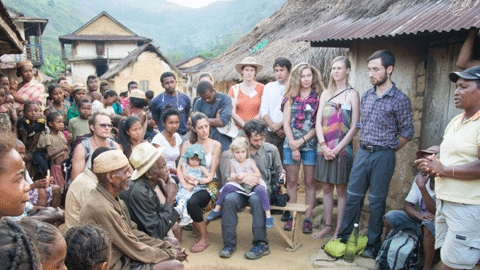Scientific expedition studies deforestation impacts in Madagascar

31/03/2016
A scientific expedition to Ranomafana National Park (Madagascar) in which ICTA-UAB researcher Álvaro Fernández-Llamazares is participating, studies the impacts of deforestation caused by the expansion of rice fields. It is an integrative project led by Dr Mar Cabeza, researcher and professor of ecology at the University of Helsinki (Finland), combining aspects of faunal changes with implications for the local peoples in the area. As part of a larger study, the scientific expedition focuses on tracking bats in Madagascar.
With a territory covering less than 2% of the surface of the whole of Africa, the island of Madagascar is the fifth country with the highest biodiversity in the world. The island includes 36% of all families of primates on the planet and more than 1,000 different species of orchids, among other examples. Madagascar counts on a large number of endemic species not found anywhere else on the planet. Therefore, it is not surprising that many ecologists and palaeontologists have named the island of Madagascar as ‘The Eight Continent’. However, considering that Madagascar is one of the countries with the lowest World Human Development Index, deforestation rates on the island are alarming. Unfortunately, more than 85% of the original forests of Madagascar have disappeared forever.
The main objective of the expedition is to analyse whether patterns of faunal changes from deforestation are similar for bats than for other animal groups. In other words, they are checking whether the composition of the bat communities found inside of Ranomafana National Park differs from the communities located on the periphery of the forests, in rural populations and forest fragments. With a rigorous experimental design, the researchers analysed the role of different indicator species, particularly sensitive to ecological changes. Apart from studying these faunal changes, they also collected samples from captured bats to study the effects of bats presence in human populations. The team studied both the contribution of insectivorous bats in reducing rice pests as well as the risk of transmission of emerging viral diseases (such as Ebola virus, Nipah and Hendri). The team also visited the towns in the periphery of the national park to analyse local perceptions towards bats and reflect on local conflicts linked to poverty, hunger and deforestation.
The dissemination website Recerca en Acció is following the scientific expedition in Madagascar. You just have to access the blog ‘Madagascar: natura i biodiversitat al vuitè continent’ to enjoy their story. Recerca en Acció has followed this group of ecologists and biologists, bringing the lush fauna and flora of Madagascar to the screens of our computers. With a lively prose and an informative tone, researchers have shared for the first time their journal diaries.